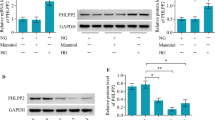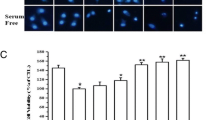Abstract
The pathological increase in the levels of the second messenger nitric oxide (NO) in the vitreous cavity and retina leads to injury and cell death of the retinal pigment epithelium (RPE) cells and eventually may contribute to the occurrence and development of diabetic retinopathy. In this study, we developed a cellular model of retinopathy using D407 cells (a human RPE cell line) exposed to sodium nitroprusside (SNP) and investigated the protective effect of the insulin-like growth factor-1 (IGF-1) towards this insult. Cell death and apoptosis were examined by the methyl thiazolyl tetrazolium assay and Hoechst staining, respectively. Specific inhibitors were used and phosphorylation of relevant signaling proteins was determined by Western blotting. SNP, in a concentration-dependent fashion, increased the production of reactive oxygen species (ROS) and lipid peroxidation process causing cell death by apoptosis of D407 cells. IGF-1, in a time- and dose-dependent manner, conferred protection towards SNP-mediated insult. Both phosphatidylinositol-3-kinase/protein kinase B (PI3K/Akt) and mitogen-activated protein kinase (MAPK) were activated by IGF-1 in relation to the protective effect. Blockade of the PI3K/Akt pathway abolished the protective effect of IGF-1 whereas inhibition of the MAPK pathway was ineffective. SNP decreased the phosphorylation of Akt in the cells while IGF-1 reversed this inhibitory effect. These results indicate that the protective effect of IGF-1 on D407 exposed to SNP insult is mediated by the PI3K/Akt pathway. This proposal may be exploited in the clinic to improve the viability of insulted retinal cells for maintaining physiological vision.







Similar content being viewed by others
Abbreviations
- Akt:
-
Protein kinase B
- BRB:
-
Blood retinal barrier
- DCFH-DA:
-
2′,7′-dichlorofluoresceindiacetate
- ERK1/2:
-
Extracellular regulated protein kinases 1/2
- IGF-1:
-
Insulin-like growth factor-1
- MAPK:
-
Mitogen-activated protein kinase
- MDA:
-
Malondialdehyde
- NO:
-
Nitric oxide
- NOS:
-
Nitric oxide synthases
- PI3K:
-
Phosphatidylinositol 3-kinase
- ROS:
-
Reactive oxygen species
- RPE:
-
Retinal pigmented epithelium
- SNP:
-
Sodium nitroprusside
References
Awata T, Neda T, Iizuka H, Kurihara S, Ohkubo T, Takata N, Osaki M, Watanabe M, Nakashima Y, Sawa T, Inukai K, Inoue I, Shibuya M, Mori K, Yoneya S, Katayama S (2004) Endothelial nitric oxide synthase gene is associated with diabetic macular edema in type 2 diabetes. Diabetes Care 27:2184–2190
Bai L, Zhang Z, Zhang H, Li X, Yu Q, Lin H, Yang W (2008) HIV-1 Tat protein alter the tight junction integrity and function of retinal pigment epithelium: an in vitro study. BMC Infect Dis 8:77
Barber AJ, Nakamura M, Wolpert EB, Reiter CE, Seigel GM, Antonetti DA, Gardner TW (2001) Insulin rescues retinal neurons from apoptosis by a phosphatidylinositol 3-kinase/Akt-mediated mechanism that reduces the activation of caspase-3. J Biol Chem 276:32814–32821
Baynes JW, Thorpe SR (1999) Role of oxidative stress in diabetic complications: a new perspective on an old paradigm. Diabetes 48:1–9
Chou WW, Chen KC, Wang YS, Wang JY, Liang CL, Juo SH (2013) The role of SIRT1/AKT/ERK pathway in ultraviolet B induced damage on human retinal pigment epithelial cells. Toxicol In Vitro 27:1728–1736
Chu Q, Moreland R, Yew NS, Foley J, Ziegler R, Scheule RK (2008) Systemic insulin-like growth factor-1 reverses hypoalgesia and improves mobility in a mouse model of diabetic peripheral neuropathy. Mol Ther 16:1400–1408
Clarkson PM, Thompson HS (2000) Antioxidants: what role do they play in physical activity and health? Am J Clin Nutr 72:637S–646S
Dastidar SG, Landrieu PM, D’Mello SR (2011) FoxG1 promotes the survival of postmitotic neurons. J Neurosci 31:402–413
Frank RN (2004) Diabetic retinopathy. N Engl J Med 350:48–58
Gan L, Zheng W, Chabot JG, Unterman TG, Quirion R (2005) Nuclear/cytoplasmic shuttling of the transcription factor FoxO1 is regulated by neurotrophic factors. J Neurochem 93:1209–1219
Guvakova MA (2007) Insulin-like growth factors control cell migration in health and disease. Int J Biochem Cell Biol 39:890–909
Holtkamp GM, Kijlstra A, Peek R, de Vos AF (2001) Retinal pigment epithelium-immune system interactions: cytokine production and cytokine-induced changes. Prog Retin Eye Res 20:29–48
Huang CC, Chen KL, Cheung CH, Chang JY (2013) Autophagy induced by cathepsin S inhibition induces early ROS production, oxidative DNA damage, and cell death via xanthine oxidase. Free Radic Biol Med 65:1473–1486
Humbert S, Bryson EA, Cordelières FP, Connors NC, Datta SR, Finkbeiner S, Greenberg ME, Saudou F (2002) The IGF-1/Akt pathway is neuroprotective in Huntington's disease and involves Huntingtin phosphorylation by Akt. Dev Cell 2:831–837
Ivanisevic L, Zheng W, Woo SB, Neet KE, Saragovi HU (2007) TrkA receptor “hot spots” for binding of NT-3 as a heterologous ligand. J Biol Chem 282:16754–16763
Jehle PM, Jehle DR, Mohan S, Böhm BO (1998) Serum levels of insulin-like growth factor system components and relationship to bone metabolism in Type 1 and Type 2 diabetes mellitus patients. J Endocrinol 159:297–306
Kubes P, Suzuki M, Granger DN (1991) Nitric oxide: an endogenous modulator of leukocyte adhesion. Proc Natl Acad Sci U S A 88:4651–4655
Kummer A, Pulford BE, Ishii DN, Seigel GM (2003) Des(1–3)IGF-1 treatment normalizes type 1 IGF receptor and phospho-Akt (Thr 308) immunoreactivity in predegenerative retina of diabetic rats. Int J Exp Diabesity Res 4:45–57
Martin DM, Yee D, Feldman EL (1992) Gene expression of the insulin-like growth factors and their receptors in cultured human retinal pigment epithelial cells. Brain Res Mol Brain Res 12:181–186
Miranda S, González-Rodríguez Á, García-Ramírez M, Revuelta-Cervantes J, Hernández C, Simó R, Valverde ÁM (2012) Beneficial effects of fenofibrate in retinal pigment epithelium by the modulation of stress and survival signaling under diabetic conditions. J Cell Physiol 227:2352–2362
Mishra A, Newman EA (2010) Inhibition of inducible nitric oxide synthase reverses the loss of functional hyperemia in diabetic retinopathy. Glia 58:1996–2004
Miyamoto K, Ogura Y (1999) Pathogenetic potential of leukocytes in diabetic retinopathy. Semin Ophthalmol 14:233–239
Negi A, Vernon SA (2003) An overview of the eye in diabetes. J R Soc Med 96:266–272
Rosales MA, Silva KC, Duarte DA, de Oliveira MG, de Souza GF, Catharino RR, Ferreira MS, Lopes de Faria JB, Lopes de Faria JM (2014) S-nitrosoglutathione inhibits inducible nitric oxide synthase upregulation by redox posttranslational modification in experimental diabetic retinopathy. Invest Ophthalmol Vis Sci 55:2921–2932
Schmidt RE, Dorsey DA, Beaudet LN, Plurad SB, Parvin CA, Miller MS (1999) Insulin-like growth factor I reverses experimental diabetic autonomic neuropathy. Am J Pathol 155:1651–1660
Seigel GM, Lupien SB, Campbell LM, Ishii DN (2006) Systemic IGF-I treatment inhibits cell death in diabetic rat retina. J Diabet Complicat 20:196–204
Simó R, Lecube A, Segura RM, García Arumí J, Hernández C (2002) Free insulin growth factor-I and vascular endothelial growth factor in the vitreous fluid of patients with proliferative diabetic retinopathy. Am J Ophthalmol 134:376–382
Slomiany MG, Rosenzweig SA (2004) IGF-1-induced VEGF and IGFBP-3 secretion correlates with increased HIF-1 alpha expression and activity in retinal pigment epithelial cell line D407. Invest Ophthalmol Vis Sci 45:2838–2847
Tao Y, Lu Q, Jiang YR, Qian J, Wang JY, Gao L, Jonas JB (2010) Apelin in plasma and vitreous and in fibrovascular retinal membranes of patients with proliferative diabetic retinopathy. Invest Ophthalmol Vis Sci 51:4237–4242
Vasilaki A, Papadaki T, Notas G, Kolios G, Mastrodimou N, Hoyer D, Tsilimbaris M, Kouroumalis E, Pallikaris I, Thermos K (2004) Effect of somatostatin on nitric oxide production in human retinal pigment epithelium cell cultures. Invest Ophthalmol Vis Sci 45:1499–1506
Waldbillig RJ, Pfeffer BA, Schoen TJ, Adler AA, Shen-Orr Z, Scavo L, LeRoith D, Chader GJ (1991) Evidence for an insulin-like growth factor autocrine-paracrine system in the retinal photoreceptor-pigment epithelial cell complex. J Neurochem 57:1522–1533
Wang H, Zhou X, Huang J, Mu N, Guo Z, Wen Q, Wang R, Chen S, Feng ZP, Zheng W (2013a) The role of Akt/FoxO3a in the protective effect of venlafaxine against corticosterone-induced cell death in PC12 cells. Psychopharmacology (Berl) 228:129–141
Wang J, Tang Y, Zhang W, Zhao H, Wang R, Yan Y, Xu L, Li P (2013b) Insulin-like growth factor-1 secreted by brain microvascular endothelial cells attenuates neuron injury upon ischemia. FEBS J 280:3658–3668
Yang X, Wei A, Liu Y, He G, Zhou Z, Yu Z (2013) IGF-1 protects retinal ganglion cells from hypoxia-induced apoptosis by activating the Erk-1/2 and Akt pathways. Mol Vis 19:1901–1912
Zhang XR, Zhang ZJ, Jenkins TA, Cheng WR, Reynolds GP (2010) The effect of chronic antipsychotic drug administration on nitric oxide synthase activity and gene expression in rat penile tissues. Eur Neuropsychopharmacol 20:211–217
Zheng WH, Quirion R (2009) Glutamate acting on N-methyl-D-aspartate receptors attenuates insulin-like growth factor-1 receptor tyrosine phosphorylation and its survival signaling properties in rat hippocampal neurons. J Biol Chem 284:855–861
Zheng WH, Kar S, Quirion R (2002) Insulin-like growth factor-1-induced phosphorylation of transcription factor FKHRL1 is mediated by phosphatidylinositol 3-kinase/Akt kinase and role of this pathway in insulin-like growth factor-1-induced survival of cultured hippocampal neurons. Mol Pharmacol 62:225–233
Zhou Y, Gong G, Yang W, Wang Y, Xu J, Xu Y (2012) The cardioprotective effect of TG-6, a newly synthesized compound, on ischemia-reperfusion injury in rats. Eur J Pharmacol 683:190–196
Disclosure Statement, Funding, and Role of Funding Source
This work was supported by Funding from Guangdong Science and Technology Department (No. 2011B050200005), National Natural Science Fund of China (No 31371088); Funding of State Key Laboratory of Ophthalmology, Zhongshan Ophthalmic Center, Sun Yat-sen University, Guangzhou, China; Funding from Chinese State Administration of Foreign Experts Affairs for high end expert (PJL).
The sources of funding had no role in the design and conduct of this project or in the preparation of the manuscript.
Author information
Authors and Affiliations
Corresponding author
Additional information
Haitao Wang and Sufen Liao Authors contributed equally to this work.
Rights and permissions
About this article
Cite this article
Wang, H., Liao, S., Geng, R. et al. IGF-1 Signaling via the PI3K/Akt Pathway Confers Neuroprotection in Human Retinal Pigment Epithelial Cells Exposed to Sodium Nitroprusside Insult. J Mol Neurosci 55, 931–940 (2015). https://doi.org/10.1007/s12031-014-0448-7
Received:
Accepted:
Published:
Issue Date:
DOI: https://doi.org/10.1007/s12031-014-0448-7




